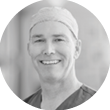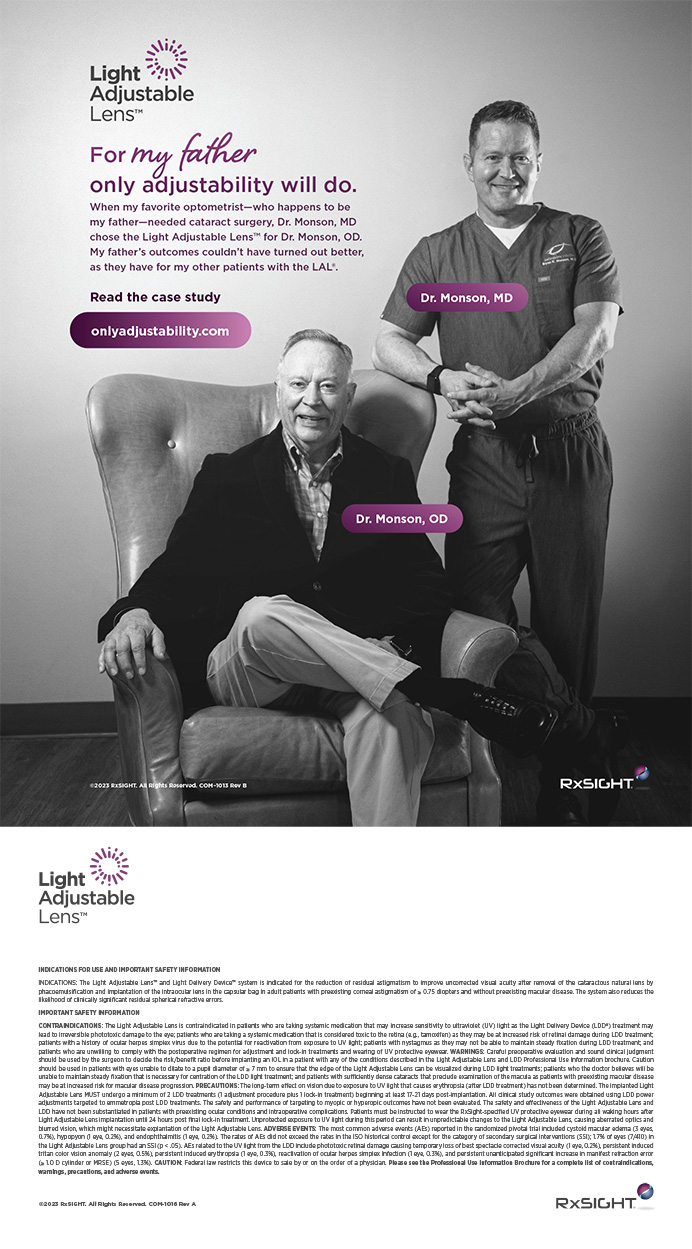Robert K. Maloney, MD, came into focus in the ophthalmic community as a LASIK pioneer. As his career developed, he was an early adopter of collaborative care with optometry, and he gained further recognition when he reembraced lenticular surgery just as premium IOLs were transforming cataract surgery into refractive cataract surgery. He did this while growing the Los Angeles–based Maloney Vision Institute (Figure 1) into a high-end solo practice known for precise outcomes and innovative care—as well as for treating more than his fair share of celebrity patients. When your zip code is 90210, entertainers and athletes come with the territory (Figure 2).

Figure 1. Maloney Vision Institute.

Figure 2. Photos of athletes and entertainers who have had surgery at Maloney Vision Institute line the walls.
Now that he’s approximately 60,000 procedures into his career, Dr. Maloney says people often ask him, “What’s your secret?” as though building a premium practice and developing a brand that consumers equate with the best were a magic trick.
“The truth,” Dr. Maloney told CRST, “is that what I’ve done over the past 2 decades is just blocking and tackling. There’s no genius to it at all. It’s simply a matter of paying attention to 100 little details every day to make sure they’re done properly. A lot of physicians don’t pay attention to those details. If I see that patients are waiting, we hire more staff or adjust schedules; if we learn that optometrists who refer to us are not getting communication back after we see their patients, we track down where the communication breakdown is and we put a process into place to fix it. There’s nothing that we’ve done that is particularly brilliant; we’ve just been persistent at solving every little problem for 20 years, and I have not hesitated to spend money to solve those problems.”
If quickly responding to problems and being acutely attentive to details represent half of Dr. Maloney’s strategy, delegating everything except surgery is the other half. “The problem with massive practice growth is that things may start to slip, and sometimes it’s quality that starts to slip. The way I prevented that from happening is by being efficient about delegating and by implementing processes and structure,” he said. “That formula allows me to do the surgery and have everything else handled by the 20 people on my staff. The benefit is that I have the infrastructure and support that allows me to do a lot of surgery, and the more surgery you do, the better you get. No matter which way you look at it, growth has benefited my practice.”
This strategy has been so successful that his solo practice was ripe for expansion, and in response Dr. Maloney recently brought on his first surgeon partner—cataract, refractive, and cornea surgeon Neda Shamie, MD. Dr. Shamie is formerly of Devers Eye Institute in Portland, Oregon, and the USC Roski Eye Institute in Beverly Hills.

Figure 3. Dr. Shamie became a partner in Maloney Vision Institute in April.
This is the first time in Dr. Maloney’s career that he has taken on a physician partner (Figure 3). “I think there is a value in being bigger, and that is what drove me to bring on a partner,” he said. “I have a gigantic practice, and there are very few people who could handle it. I needed somebody who could essentially be like me, by which I mean handle a huge practice and handle it in a way that the quality of care does not diminish. Dr. Shamie is a brilliant surgeon, and she has the personality and the smarts to handle a practice like this.”
Dr. Maloney explained that, during the years that Dr. Shamie was growing her own nearby Beverly Hills practice, he had her in his metaphorical line of vision as a potential partner. “She had built a really superb high-quality practice, and I needed somebody who could handle my practice and I wanted to add services, so it made perfect sense. Dr. Shamie brought cornea, which I was not doing, and she is also a cataract and refractive surgeon, so it made her a perfect fit to take over some of my workload and for us to expand our service offerings.”
Dr. Shamie described being a part of the Maloney Vision Institute as a blessing that is taking her career to another level. “The Maloney Vision Institute is among a small selection of truly premier practices in the country,” she said. “Dr. Maloney has optimized and streamlined the practice in such a way that patients can count on a surgical experience second to none. Every staff member is expertly trained and knowledgeable, can answer patients’ initial questions with great competence, and prepares patients for the doctor’s evaluation in a consistent and reliable fashion. This high level of professionalism builds confidence and elevates the patient experience in such a way that I have never seen in any other practice.”
Since joining Maloney Vision Institute, she said, she also benefits from that paradigm, and she is grateful to Dr. Maloney for the work that he put into building it. “I now can focus on offering patients my clinical and surgical expertise and feel confident that everything else around me is elevated to the high standard to which I hold myself. I am truly grateful that Robert recognized my potential in the way I was trying to manage, build, and expand my practice. I just simply could not maximize my potential until I came under the umbrella of Maloney Vision and the mechanism of practice that he’s created. My care of patients and my surgical approach have not changed from how I previously practiced, but because I was not in a setting in which the infrastructure was streamlined and perfected as it is at Maloney Vision, I had reached a threshold as to how much I could grow. Now I feel like the sky’s the limit.”
In the question-and-answer session that follows, the two physicians discuss Maloney Vision Institute’s excellence factor, how their careers have intersected to bring about this partnership, and why, as Dr. Shamie says, “Everyone deserves a 90210 experience.”

CRST: How would you describe your practice?
Robert K. Maloney, MD: My practice is a premium cataract and refractive practice that now also includes a cornea service. We rely heavily on word of mouth and a mixture of OD and MD referrals, and we are known for high-quality care, which is necessary to get referrals from patients and providers. I am one of the busiest cataract and refractive surgeons around, and that is unusual for a solo practice, which Maloney Vision Institute was until just a few months ago.
I was one of the pioneers of LASIK, which gave me a major head start in practice, and I was one of the earliest ophthalmic surgeons forming alliances with people in the optometric community in the Los Angeles area, so I have a fairly unique niche there. We also have a superb marketing section, and that led to us reaching out to potential patients online in the early days of the internet.
CRST: Is there someone specific on The Maloney Vision Institute staff who is crucial to the practice process that enables you to focus on surgery while still being attentive to details?
Dr. Maloney: Pamela Sullivan, our practice administrator and chief operating officer, has been with us for 20 years, and she handles the day-to-day operations. She and I make a great team because I’m a concept person full of ideas about ways to solve problems quickly, and she’s a process person who reels me in and reminds me that we need to implement change with an eye toward the disruption it causes. She filters my ideas so that everything works smoothly as plans are implemented.
CRST: Dr. Shamie, your new partner says that there’s no secret to Maloney Vision Institute’s success—that it’s all just blocking and tackling. What do you think?

Neda Shamie, MD: Dr. Maloney makes it seem so easy. I think the secret to his success is that he prioritizes solving problems and addresses them right away. Most people don’t; they just sweep them under the rug. He doesn’t lead by fear; he leads by empowerment. He’s open to feedback, and, more important, he addresses feedback. Staff members feel comfortable communicating when there is a problem because they know it will be heard and acted upon. That’s a huge part of Dr. Maloney’s leadership style, and it’s something I hope I can capture in myself.
Another component of Maloney Vision Institute’s success is that Dr. Maloney surrounds himself with really smart people. The people who have leadership roles here are exceptional at what they do. I like to say, jokingly, that he chose me, so he must have a knack for picking the best people.
I am a Doctor, And I Play One on TV
In addition to being brilliant surgeons and partners in the Maloney Vision Institute, Robert K. Maloney, MD, and Neda Shamie, MD, share a notable distinction. They are (most likely) the most televised ophthalmologists anywhere.
Dr. Maloney was the featured refractive surgeon on the previous decade’s prime-time TV program Extreme Makeover. He was responsible for providing laser vision correction to the weekly makeover recipient if he or she was an appropriate surgical candidate. He says his exposure to millions of weekly viewers catapulted his practice into the national spotlight and helped brand him as the go-to surgeon in the Los Angeles area. More recently, Dr. Maloney has been featured on The Doctors, a daily daytime television program (Figure 1). On this show, Dr. Maloney explains various refractive procedures to viewers, and he sometimes performs on-air surgery for eligible candidates (https://youtu.be/7Xd1jRLY1CY).

Figure 1. Dr. Maloney discussed refractive surgery options on an episode of The Doctors.
Dr. Shamie grew up the daughter of a prominent psychiatrist who has a television program on Iran TV, a network that serves the Persian-speaking community in North America and elsewhere. His program educates viewers about psychiatric issues. Through this exposure, Dr. Shamie became familiar with the process of producing a TV show, and sometimes she helped her father with his program. That experience—and the fact that the camera loves her—set her on track to be a frequent guest on local television news programs when they had a segment that called for an articulate expert on ophthalmic issues (Figure 2).

Figure 2. Dr. Shamie discussed innovative ophthalmic procedures on local news programming.
“I did this early in my career, especially when I was practicing in Portland,” she said. “I was the first to do keratoprosthesis and refractive cataract surgery in the Northwest, and doing cutting-edge surgery made me newsworthy.”
More recently, Dr. Shamie has appeared in nationally televised commercials for »Restasis (cyclosporine ophthalmic emulsion 0.05%, Allergan).
“The value of TV is that it is a great way to educate our patients and the general public,” she said. “When they asked me to do the commercial for Restasis, for me it was less about the commercial and more about the fact that I could use it as a vehicle to bring about greater public knowledge about dry eyes.”
CRST: Dr. Shamie, did you know you were being sized up as a potential partner?
Dr. Shamie: I have known Dr. Maloney my entire career, from the time I was a resident. He has, for the past 20-plus years, set a standard that we all aim to recreate in our own practices. So, even before I moved to Los Angeles 8 years ago, I had reached out to Dr. Maloney for advice and guidance. Later, when I was on the faculty at USC Eye Institute, we were presenting at the same meeting, and we talked and went on to share several patients. I would refer refractive surgical patients to him, and he would refer his cornea patients to me. About 4 years ago, the possibility of my partnering with Dr. Maloney was broached, but at the time I was still very much in the mindset that I wanted to stay in academia and try to build my own practice.
CRST: What changed your mind?
Dr. Shamie: One of the first conversations we had when we started talking seriously about my joining the practice began with him asking me to give him a wish list of what I would need to make the move. Usually when someone of the caliber of Dr. Maloney is bringing on a junior person, the conversation is more about what he or she expects of you. Dr. Maloney approached it differently, and just that simple opening line made all the difference. It became clear that he was open to my needs and willing to incorporate my input in the vision for the future of the practice. Now it has become this symbiotic relationship through which we are trying to build the practice to the best of both of our abilities, taking advantage of each of our strengths.
CRST: A practice is a business, but there’s much more to it than the bottom line. Do you have an emotional investment in the Maloney Vision Institute?
Dr. Maloney: I never thought I would be attached to the practice itself in a way that is completely separate from my own personal success, but over time I’ve come to realize that I want to make sure that this practice grows and thrives. This is important to me because I have a large number of employees who depend on this practice to take care of themselves and their families, and I also have tens of thousands of patients who rely on this practice when they have problems with their eyes—so I want to make sure they are taken care of.
Dr. Shamie: I have always respected Dr. Maloney as a leader in the world of ophthalmology, and now I am able to turn to him as a mentor, a colleague, a partner, and a friend. This transition has been a cause for celebration for me and my entire family, as we see the incredible value of building on the foundation that Robert has created over decades. To be able to work alongside of him, to learn the inner-workings of his incredibly successful practice, and to help carry the Maloney Vision institute into the future is an opportunity of a lifetime and a gift I do not intend to take for granted.
CRST: Bringing on a partner is a big change. Now that you’ve doubled your physician contingent, what’s next?
Dr. Maloney: Triple! I figured Dr. Shamie would help take some of my workload, but she has brought a busy practice with her. I was probably overly optimistic, and we are probably going to have to get somebody else to help handle my load. But that is a good problem to have.
CRST: Do the well-heeled clients from the Beverly Hills environs demand extra pampering?
Dr. Shamie: A lot of people wonder if patient demographics influence our treatment paradigm—if we have to perform at a particular level based on patient expectations. Here’s the thing: If you have preconceived ideas about your patient population or demographic, then you are not practicing at your best. No matter where my patient is from or what his or her expectations may be, I offer the newest technology and adopt the latest techniques to reach the most optimized results. Every patient deserves a 90210 experience.




